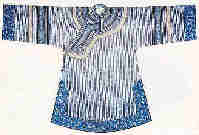 Republic of China Style
Republic of China Style
On October 10th, 1911, Sun Yet Sen initiated Xin Hai Revolution and successfully overthrew the Qing government and abolished China's dynastic and imperial control; thus established the Republic of China (1911-1949). The new government passed a "Queue Cutting Notice" and most significantly, it abolished the clothing hierarchical custom and rules, and promoted that everyone, regardless of his social status could wear what he wanted.
During the late 1920's, the new government passed out a new "Apparel Regulations" specifically regulating citizen's formal wear and government officials' uniform.
Men's wear -- suit
During the initial period of Republic of China, people continue to wear Qing Dynasty's clothing. After 1920, men from prosperous cities such as Shanghai started to wear the western style suit -- a three-piece male business suit.
Chang Pao and Ma Gua

But western style suit did not replace Chang Pao and Ma Gua, which also became men's formal wear. There were two types of pants a man can wear under Chang Pao; one was the western pants with narrower trousers, and the other was the Chinese "lantern pants" with larger trousers and a string attached to close up the trouser ends.
Ao (jacket) and Qun (skirt), the two-piece dress remained popular among female. During this era, Ao became tighter and Qun became shorter.
Cheongsams

Evolved from Qing Dynasty's Chang Pao, the typical Manchu's wear, cheongsams became Chinese women's main fashion during this period. During the early times of the Republic of China, cheongsams' style followed the Qing Dynasty: straight, and loosely fitted one-piece dress.
After the 1920's, the emergence of western culture influenced Chinese values and in turn had reflected on cheongsams. Women's contour body became an art. Therefore, cheongsams became tighter and shorter to enhance women's bodily curves. Because of cheongsams' popularity, various styles emerged; there are long skirted, short skirted, long sleeved, short sleeved, or even sleeveless cheongsams. In the 1930's, there was a growing trend in advanced cities like Shanghai, to combine western clothing with Chinese cheongsams, such as adding a puffy sleeve, or wearing a scarf or a mantle.
Top hats were quite popular during this period. In summer some wore straw hats, and in winter people wore hoods, either attached to a robe or jacket or separate. Students favored peaked or visor caps, and laborers, the terais.
While most men wore round-toed thousand-bottom cloth shoes, young men preferred western-style leather shoes. In the 1920s, plimsolls (a kind of sneakers) gained popularity among the students, and high-heel shoes for women became a new trend.
